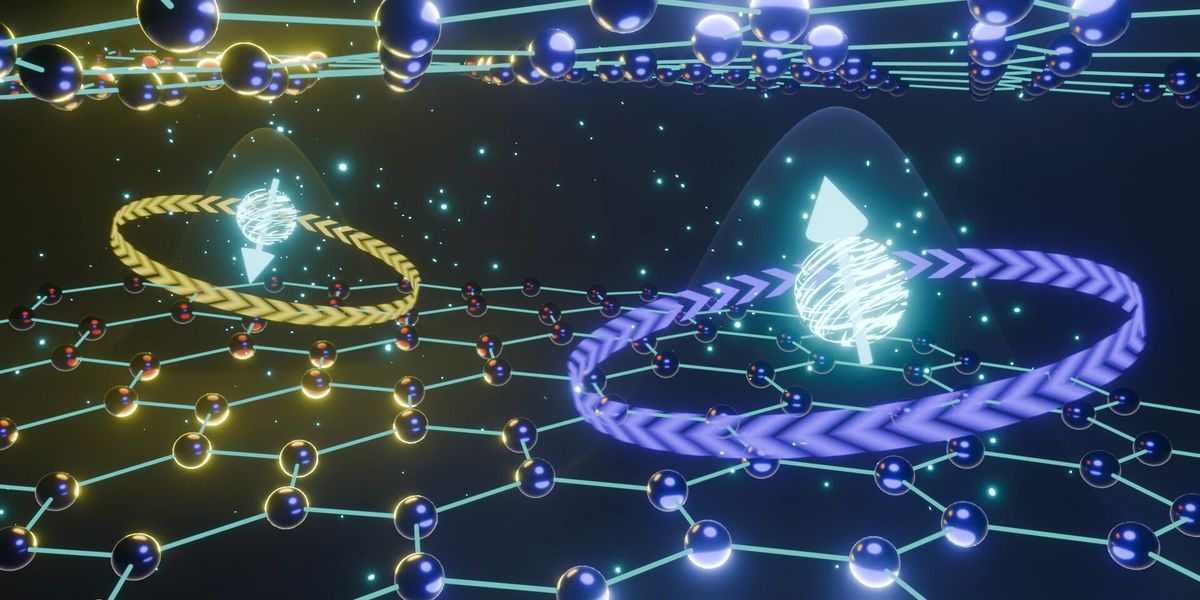Researchers at ETH Zurich have revealed exciting potential for bilayer graphene (BLG) to serve as a platform for quantum computing—with possibly longer coherence time frames and potential for simpler quantum-logic gates. The researchers have discovered a type of qubit that exists within BLG for extended periods of time, which could also open new avenues for solid-state quantum computing.
The Zurich team’s qubits are known as valley qubits. The “valley” here refers to an additional degree of freedom for electrons. Instead of relying on the electrons’ spin, like the common spin qubit found in many quantum-computer designs today, valley qubits exploit the energy level of electrons in relation to their momentum.
In the pursuit of practical quantum computing, where information encoded in qubits must be preserved and manipulated over time, the length of time a qubit can maintain coherence plays a crucial role. The researchers’ longer-lived, valley qubits, they say, maintain quantum coherence by as much as 20 times as long as spin-based qubits.
How could graphene become the silicon of quantum computing?
Graphene, a two-dimensional material composed of a single layer of carbon atoms arranged in a hexagonal lattice, has already demonstrated remarkable electronic properties. In bilayer graphene, two sheets of carbon atoms stack on top of each other, creating a unique platform with tunable band gaps through the application of an electric field perpendicular to the layers. This tunability makes it attractive for engineering quantum dots—nanoscale boxes capable of confining electrons—whose free-form properties could be exploited for quantum computing.
“The fact that the first measurements of relaxation times are already comparable to state-of-the art quantum dots in silicon without specific optimization gives room to imagine even better times in the future.” —Rebekka Garreis, ETH Zurich
Rebekka Garreis, a researcher at ETH Zurich and coauthor of this research, notes that a quantum dot nestled inside the graphene layers experience two electronic valleys. With no external magnetic field, the two energy states in this valley are the same. So, an electron in a BLG quantum dot can occupy either of the two valleys. However, if an external magnetic field is turned on, it is possible to split the two energy levels of the valleys, not unlike hyperfine splitting of an atom’s electronic energy states due to interactions between the atom’s nuclear and electronic magnetic moments.
BLG, in contrast to other materials, makes it possible to tune how fast the two valley states split apart. “This controllability and accessibility of that valley degree of freedom together with its long relaxation time makes it a suitable candidate for qubit implementation,” said Garreis.
BLG is a unique material with some attractive properties for computing, Garreis says. “The fact that the first measurements of relaxation times are already comparable to state-of-the art quantum dots in silicon without specific optimization gives room to imagine even better times in the future,” she added.
The eureka moment behind this latest research lies in the remarkable longevity of valley states, according to Garreis. The researchers report measured relaxation times for valley states in excess of 500 milliseconds, presenting promising coherence properties for future valley qubits. In contrast, the spin relaxation time in BLG, Garreis says, is somewhere below 25 milliseconds. Quantum dots in conventional semiconductors, she notes, also experience quantum coherence in or below the 25-millisecond time frame.
“The long relaxation time of valley states in BLG, exceeding 500 milliseconds, holds promise for high-quality qubit operations,” said Garreis.
The advantages of BLG as a quantum-computing platform extend beyond its long-lived valley qubits, too. Because of its unique geometry and physical properties, she adds, BLG enables in situ tuning of the valley degree of freedom, a crucial feature for hosting and controlling qubits.
Yet, the perpetual paradox of quantum computing remains challenging in this new medium. Well-shielded qubits must also somehow not be shielded very much at all—otherwise the quantum information the qubit contains could never be manipulated by quantum-logic gates. Garreis says BLG valley-qubit gates could be most readily manipulated and exploited via electrical logic gates.
By contrast, spin qubits couple only to magnetic fields, not electric ones—providing yet another challenge for a practical spin-qubit quantum computer. For instance, she notes, a spin qubit-logic gate might involve complex arrays of additional small magnets on top of the qubits or coupled arrays of neighboring nuclear spins.
The unwieldiness—and possibly challenging scaling requirements—of spin qubits make BLG valley states therefore more attractive as a quantum-computing platform, she says. “The ability to manipulate valley qubits via electric gating, without the need for additional small magnets on the sample surface, simplifies the fabrication and scalability of quantum computers,” says Garreis.
Garreis adds that one further advantage of graphene is its natural 2D structure. “Because there are many other 2D materials with different electronic and optical properties,” she says, “one can basically stack them on top of each other like Lego bricks and use the desired properties of different materials to combine them to an optimal system for qubit operations.”
The researchers published their results earlier this month in the journal Nature.
- Quantum Computing’s Hard, Cold Reality Check ›
- IBM: Quantum Computers Are Already Doing Heavy Lifting ›
Dexter Johnson is a contributing editor at IEEE Spectrum, with a focus on nanotechnology.



